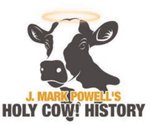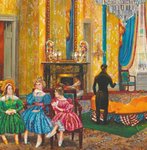The Big Cheese visits the White House
H ow do you express your appreciation to the president?
Folks in one town devised a unique gift—which carried malodorous consequences. Here’s how it all started.
Thomas Jefferson had …
This item is available in full to subscribers.
Subscribe to continue reading. Already a subscriber? Sign in
Get 50% of all subscriptions for a limited time. Subscribe today.
Please log in to continueNeed an account?
|
The Big Cheese visits the White House
How do you express your appreciation to the president?
Folks in one town devised a unique gift—which carried malodorous consequences. Here’s how it all started.
Thomas Jefferson had been president for 5 months by the summer of 1801. And a guy in New England thought he was doing a great job.
Elder John Leland was a Baptist minister who liked Jefferson’s dedication to religious liberty. He came up with a one-of-a kind gift to express his appreciation.
Cheshire, his hometown, is in the boonies of western Massachusetts. It was settled by immigrants from Cheshire, England, known for the cheddar cheese produced there. They brought their cheese-making skills with them.
One day, Elder Leland had a “Eureka!” moment. The town would send a cheddar cheese wheel to the White House.
Not just any cheese, either, but one unlike any other. The “Cheshire Mammoth Cheese.”
He invited everyone who owned a cow to bring “every quart of milk given on a given day to a great cider mill.” They wound up collecting milk from 900 cows. A large hoop was placed on the cider press. As milk was poured in, the Baptists sang and prayed and added ingredients.
They engraved “Rebellion to tyrants is obedience to God” on the side. Jefferson repeated that line often, Ben Franklin had suggested it for the national motto.
The finished product was mammoth, alright, weighing 1,234 pounds, stretching 4 feet wide and standing 15 inches tall.
Making a honking big cheese was one thing; getting it to the White House was something else.
Then nature came to the rescue.
Winter arrived early that year, and much snow came with it. Late in November, the Cheshire Mammoth Cheese was dragged by sleigh to New York City, then hoisted onto a ship and sailed to Baltimore. A wagon carried it on the final leg of the 500-mile journey, arriving in the capital December 29, 1801.
The elder presented the well-traveled cheese to Jefferson at a White House ceremony on New Year’s Day 1802. They put it in the East Room and ate. And ate. And ate. The Cheshire Mammoth Cheese was a long time disappearing.
No one knows when it finally vanished. It was present at Jefferson’s reception on New Year’s Day 1803, making the White House reek from one end to the other. It was still sitting out in March 1804, when a visitor delicately described it as “very far from being good.”
Some accounts say the dried remnants were available as late as 1805; historians believe Jefferson finally dumped the last of it into in the Potomac River.
A thoughtful person would have learned a lesson: Don’t put a gigantic, smelly food product in a public place. But proving that “those who do not learn from history are doomed to repeat it,” it happened again in 1835.
This time, a New York state dairy farmer named Thomas Meachum remembered the Cheshire Mammoth Cheese and decided to do it one better in tribute to Andrew Jackson.
Meachum’s cheddar weighed 1,400 pounds, giving Old Hickory 166 more pounds of cheese than was dropped in Jefferson’s lap. It was engraved with the words “The Union, it must be preserved.” (Cheese engraving has become a lost art, it seems.)
Meachum was generous; Vice President Martin Van Buren and New York Governor William Marcy each got 750 pounds blocks of cheddar, too.
The Big Cheese (pun intended) was sent by schooner to the White House and wheeled into the East Room. Jackson had all visitors take some home in history’s first government cheese giveaway. But he still had a ridiculous mountain of the stuff on his hands.
President #7 did what #3 did with his cheese: left it in the East Room, probably with a sign saying, “Free Cheese. Take some—please!”
Washington is oppressively hot in summertime. This even bigger cheese made an even bigger stink as it sat for another 2 years.
With Jackson’s 2nd term winding down in 1837, he devised a way to finish it off. Knowing people love free food, he held a farewell reception. More than 10,000 folks flooded the White House and choked down the last bites of cheese. Our Long National Fromage Nightmare was finally over.
Except, it wasn’t.
The cheese was gone, but its odor lingered. A lot. When Van Buren moved in, he fumigated the place and tried his best to get rid of it.
But in 1838, long after the cheese was gone, a Washington socialite wrote to a friend:
“The White House has been put in order by its new occupant. (Van Buren) says he had a hard task to get rid of the smell of cheese, and in the room where it was cut, he had to air the carpet for many days; had to take away the curtains and to paint and white-wash before he could get the victory over it. He has another cheese like that which General Jackson had, and says he knows not what to do with it. What a foolish thing for a man to have made such a present to him!”
Van Buren wisely—and quickly—got rid of his cheese. In 1839 he auctioned it off with the money going to charity. Then he put down his foot: no more giant cheese gifts!
The days of saying, “Good job, Mr. President!” with an absurdly large cheese wheel were finally over.
Have comments, questions or suggestions you’d like to share with Mark? Message him at jmp.press@gmail.com.
Other items that may interest you










Comments
No comments on this item Please log in to comment by clicking here